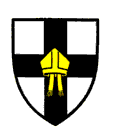Document Contents

Carlisle is a ‘new foundation’ cathedral. The cathedral church of the new diocese founded in 1133 was established in an existing priory of regular canons living under the Augustinian rule in the city. This was the only English cathedral held by this order, and remained in their hands until the English Reformation. The priory surrendered to the crown on 9 January 1540, and its revenues were used to endow the cathedral. Under a charter dated 8 May 1541 Henry VIII founded the Cathedral Church of the Holy and Undivided Trinity, and another charter assigned not only revenues from the dissolved priory but also those of the former monastic establishment at Wetheral. Statutes were delivered under the act 31 Hen. VIII c. 9 on 6 June 1545.
The clerical element of the cathedral body described in the charter consisted of a dean and four prebendaries. The first dean was the former prior of the dissolved monastic establishment. However, under both Elizabeth I and James I for some time the deanery was secularised, being held by Sir John Wooley (1577–96) and then Sir Christopher Perkins (1596–1622), both laymen.
Carlisle Cathedral suffered considerably during the mid-seventeenth century. The city was besieged by parliamentary forces in 1644, and after their victory the troops pulled down the greater part of the nave, cloisters and prebendal houses in order to use their materials in the repair of fortifications. The chapter had already been deprived and dispersed (one prebendary alone, Lewis West, surviving to be reinstated at the Restoration).
As described to the Ecclesiastical Commissioners in 1831–2, the clerical establishment of the cathedral beyond the dean and four canons included six minor canons, of whom one served as lecturer (which office was combined with that of lecturer of St Cuthbert’s Carlisle), another as sacrist, and a third as schoolmaster. The average gross yearly income of the dean and chapter was £6,443 (£5,318 net) at this date. Of this ‘surplus’ income, averaging £4,809, was divided among the chapter in six parts, the dean taking two shares; in addition the dean received just over £120 per annum, and the canons £22 5s. each. The lecturer received £100 per annum for performing his two offices, and the sacrist £1; each minor canon received £8 and a share of tithes (around £20). The canons and minor canons had no separate individual estates. No stall was annexed to the archdeaconry; the four prebernds were in the gift of the bishop.
Patronage
In 1831 as recorded by the Ecclesiastical Commissioners the dean and chapter of Carlisle had 27 livings in their gift in the diocese of Carlisle (almost one quarter of the total): Addingham; Appleby; Bassenthwaite; Bewcastle; Camerton; Christ Church, St Cuthbert’s, St Mary’s and Trinity Church Carlisle; Castlecarrock; Castle Sowerby; Crosscanonby; Cumrew; Cumwhitton; Edenhall; Hayton; Hesket; Hutton; Ireby; Kirkland; Morland; Rockcliff; Sebergham; Thursby; Westward; Wetheral with Warwick; and Wreay. In addition they held two Northumberland livings in the diocese of Durham: Corbridge and Whittingham.


